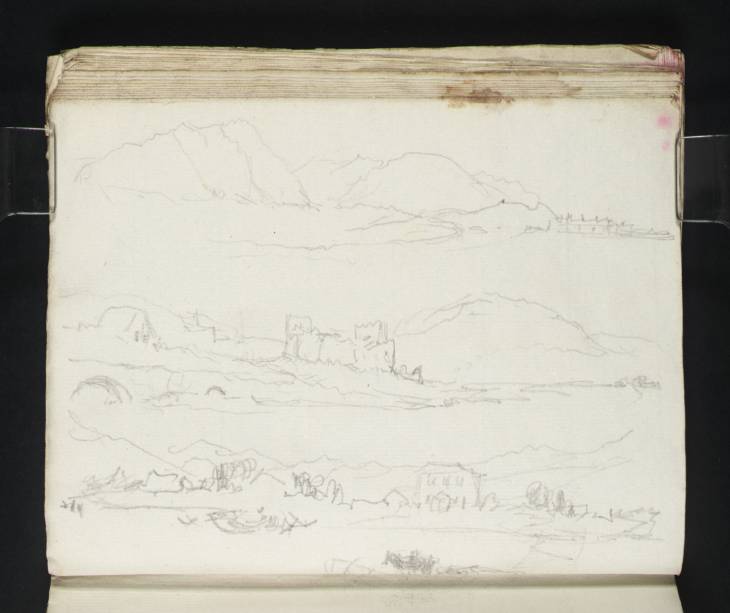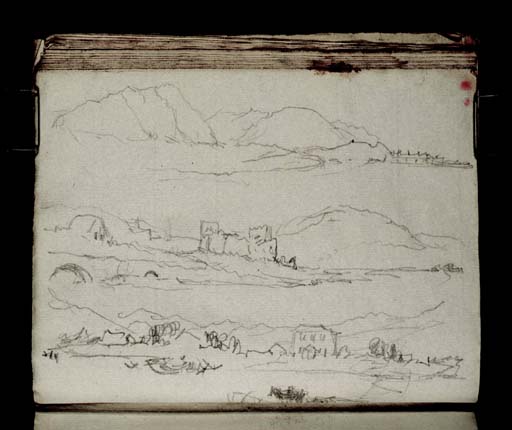J.M.W. Turner
>
1830-35 Annual tourist
>
Scotland 1831
>
Fort Augustus Sketchbook
>
Artwork
Joseph Mallord William Turner Sketches of the Caledonian Canal at Muirton, Inverness 1831
Image 1 of 2
Joseph Mallord William Turner,
Sketches of the Caledonian Canal at Muirton, Inverness
1831
Joseph Mallord William Turner 1775–1851
Folio 46 Verso:
Sketches of the Caledonian Canal at Muirton, Inverness 1831
D27043
Turner Bequest CCLXXVI 46a
Turner Bequest CCLXXVI 46a
Pencil on off-white laid writing paper, 150 x 183 mm irregular
Accepted by the nation as part of the Turner Bequest 1856
References
1909
A.J. Finberg, A Complete Inventory of the Drawings of the Turner Bequest, London 1909, vol.II, p.882, CCLXXVI 46a, as ‘Ruined castle, with mountains.’.
These three sketches may have been made at Muirtown Basin at the end of the Caledonian Canal in Inverness. If so, they complete the record of Turner’s journey along the canal, which he began at Corpach near Fort William at the start of this sketchbook (folio 2; D26967). The identification is based on an unpublished note by Janet Carolan which suggests that the building depicted in the bottom sketch may be ‘Muirton House’.1 The exact identity of this house is uncertain,2 but the suggestion that this is a view across Muirtown Basin at Inverness is convincing. There are boats at the left, and the straight, vertical banks indicate that it is a wide canal. Beneath the sketch in the page gutter is a small sketch, drawn in silhouette, of a horse with a man standing behind it.
Carolan suggests that the middle sketch on this page may show the ‘Old Toll House’.3 The structure is now a ruin, but a painting of it by Pierre Delavault (1859–1907) reveals that it once looked quite different from Turner’s sketch. The ruin is therefore unidentified, but the sketch of it may also have been made around Muirtown.
At the top of the page is a sketch of hills across a stretch of water with what looks like a canal lock gate at the right. This may be the lock that connects the Caledonian Canal to the Moray Firth, making this a view north across the Firth.
Having reached the end of the Caledonian Canal, and the last page of his sketchbook, Turner was nearly ready to consider this sketchbook finished as a neat record of his journey up the Caledonian Canal from Corpach to Inverness. He may, however, have opened the book twice more, filling the blank space on folios 2 and 20 verso (D6967, D27001) with a few final sketches of Inverness.
Thomas Ardill
April 2010
Many of these were identified by David Wallace-Hadrill and Janet Carolan, ‘Turner’s 1831 Sketchbook T.B. CCLXXVI Fort Augustus’, [circa 1992–3], Tate catalogue files, [unpaginated].
Carolan’s note refers to an 1823 print that has not been identified. There is a Muirtown House (built in 1826) in Charleston Place to the west of Muirtown Basin, but this was apparently built in 1826 and so post-dates the engraving. In its present state it is also too large to be the same building as is shown in Turner’s sketch (‘Inverness, 1–8 Charleston Place, Muirtown House’, Scottish Places, accessed 20 April 2010, http://www.scotlandsplaces.gov.uk/search_item/index.php?service=RCAHMS&id=98280 ). An alternative is the Canal House on the Clachnaharry Road which runs alongside the canal basin. In a photograph from the Royal Commission on the Ancient and Historical Monuments of Scotland, the building looks quite similar, having the correct number of windows, though in the photograph they are dormer windows and in Turner’s sketch they are not (‘Inverness, Clachnaharry Road, Muirtown Cottage’, Royal Commission on the Ancient and Historical Monuments of Scotland, accessed 20 April 2010, http://canmore.rcahms.gov.uk/en/site/98325/digital_images/inverness+clachnaharry+road+muirtown+cottage/ ).
How to cite
Thomas Ardill, ‘Sketches of the Caledonian Canal at Muirton, Inverness 1831 by Joseph Mallord William Turner’, catalogue entry, April 2010, in David Blayney Brown (ed.), J.M.W. Turner: Sketchbooks, Drawings and Watercolours, Tate Research Publication, December 2012, https://www


